How to deploy your Apps in serverless-way using App Engine.pptx
Download as PPTX, PDF0 likes71 views
Deploy your apps using Google Cloud service, App Engine. It is server-less service for deploying apps. You don't need worry about hardware, installation, operation and maintenance. You only focus with your business and application.
1 of 32
Download to read offline





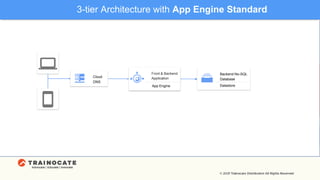
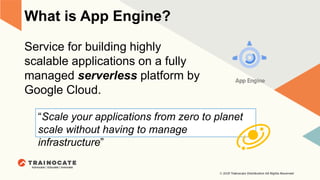
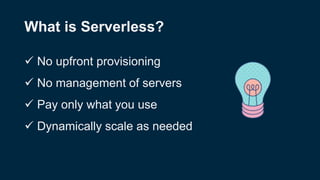
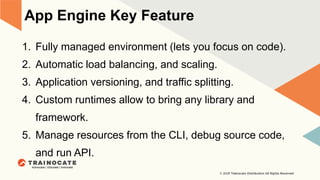

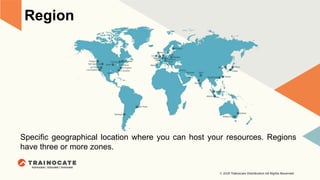
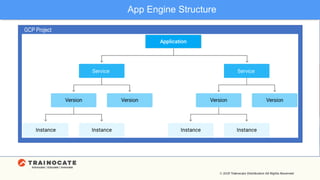
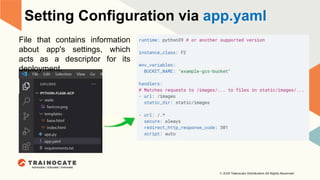
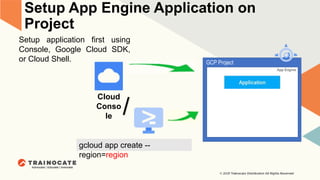
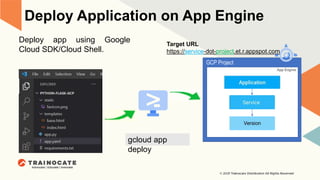

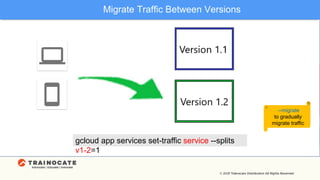



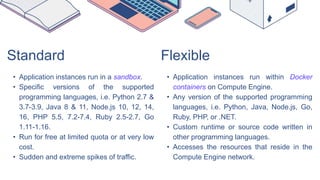






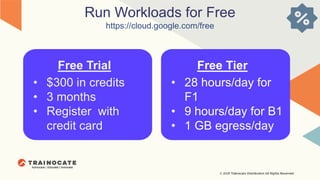



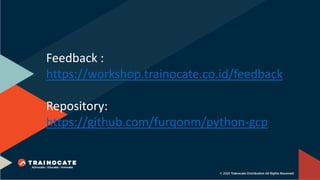
Ad
Recommended
A tale in automation (Puppet to Ansible)



A tale in automation (Puppet to Ansible)neptunerx This document discusses a company's migration from Puppet to Ansible for infrastructure automation. It provides an overview of the company's cloud platform and automation needs. It then compares Puppet and Ansible, noting Ansible's advantages for the company's use case such as its lower learning curve and more human-readable scripts. The document outlines the process used to develop Ansible scripts and notes improvements in results and future plans to enhance the automation roadmap.
Infrastructure as code



Infrastructure as codeAakash Singhal The document discusses infrastructure as code (IaC) and the tool Terraform. IaC allows infrastructure to be provisioned and managed using code and version control. This makes infrastructure reusable, testable, and maintainable. Terraform is an open-source IaC tool that uses declarative configuration files to manage cloud infrastructure in a cloud-agnostic way. It generates execution plans to show exactly what changes will be made before implementing them. This allows infrastructure to be created reproducibly.
Infrastructure as Code



Infrastructure as CodeMatt Cowger This document discusses treating infrastructure as code by defining all components needed to run services (e.g. servers, software, configurations, etc.) in text files that can be version controlled, shared, and programmatically deployed to ensure all infrastructure is consistently configured and deployed. Doing so allows for automation, removes inconsistencies between environments, and prevents human errors that can cause outages. Examples are given of firms that experienced major outages due to manual processes and inconsistencies between environments.
Serverless Summit - Quiz



Serverless Summit - QuizCodeOps Technologies LLP The document contains a 10 question quiz about serverless computing concepts. It begins by explaining that the term "lambda" in serverless functions originates from Alonzo Church's "lambda calculus" in 1936. Each question is then presented along with the corresponding answer and brief explanation. The questions cover topics like principles for creating lambda functions, suitable and unsuitable use cases for serverless, where to store credentials, characteristics of serverless functions, the "freeze/thaw cycle", and approaches to avoid for state management.
Infrastructure as Code



Infrastructure as CodeLeandro Rosa It's time to apply software practices to IT infrastructure. Here is an introduction to Infrastructure as Code.
What's new in ASP.NET vNext



What's new in ASP.NET vNextGunnar Peipman Gunnar Peipman discusses what's new in ASP.NET vNext. Key updates include support for true side-by-side deployment, a cloud optimized .NET Core runtime that takes up only 11MB, and ASP.NET components being merged into a single framework. ASP.NET vNext apps are designed to be cloud ready. The new K runtime features multiple layers including the CLR native host and managed entry point. KVM and KPM are also introduced as tools for managing the K runtime and packages.
Serverless



ServerlessMaciej Dziergwa IT world is full of buzzwords popping out every year like popcorn. Serverless is one such word. This presentation is to demystify meaning and show areas of application for such an approach. It presents exemplary use cases and shows advantages as well as drawbacks of Serverless.
AppScale @ LA.rb



AppScale @ LA.rbChris Bunch These are my slides from my talk at LA.rb, covering research at UCSB on the AppScale project. This is a condensed version of the talk I gave at SBonRails - see that talk for about twice as much material on these topics.
AppScale + Neptune @ HPCDB



AppScale + Neptune @ HPCDBChris Bunch 1) AppScale is an open source platform that can automatically configure and deploy HPC codes, databases, and web services across hybrid cloud infrastructures like Amazon EC2 and Eucalyptus with minimal user input.
2) Neptune is a domain-specific language that works with AppScale to automate deployment of MPI, UPC and other HPC applications across dynamic node allocations in the cloud with a single command.
3) The presentation demonstrates how AppScale and Neptune can provide a "one button" deployment experience for scientists to run applications and store data across public and private clouds in a fault-tolerant and portable manner.
DevOps: Infrastructure as Code



DevOps: Infrastructure as CodeJulio Aziz Flores Casab Infrastructure as Code, tools, benefits, paradigms and more.
Presentation from DigitalOnUs DevOps: Infrastructure as Code Meetup (September 20, 2018 - Monterrey Nuevo Leon MX)
Fast Deployments to Multiple Golang Lambda Functions



Fast Deployments to Multiple Golang Lambda FunctionsKp Krishnamoorthy Describes the process we use at Fender to achieve low build times while deploying to our Golang AWS Lambda microservices.
The future of cloud programming



The future of cloud programmingJason Straughan In this talk we will cover:
1. Using concurrency to maximize hardware (Elixir, Clojure, Haskell)
2. Serverless technologies for backend architecture (Amazon AWS Lambda, Microsoft Azure Cloud Functions)
3. BaaS – Backend as a Service (Google Firebase, etc)
ONAP on Vagrant



ONAP on VagrantVictor Morales Setting up an ONAP development environment is not easy. Development tools and practices are not collected in a single place. This project pretends to collect and standardize that process.
Serverless Architecture Patterns - Manoj Ganapathi - Serverless Summit



Serverless Architecture Patterns - Manoj Ganapathi - Serverless SummitCodeOps Technologies LLP -- Presented in Serverless Summit 2017 - www.inserverless.com --
The earlier sessions at this conference covered development scenarios & operations, frameworks/platforms, and technology applications. In this session, I'll tie them together to provide a perspective on architectures and patterns for serverless. I'll cover how serverless compute can be used as glue or backend, legacy API proxy, or do real-time processing. Further, I'll discuss how serverless can be employed for web applications, batch processing, stream processing and event-driven automation, at a high level.
How to setup a development environment for ONAP



How to setup a development environment for ONAPVictor Morales Presentation used during the ONAP session
https://onapbeijing2017.sched.com/event/D5q3/how-to-setup-a-development-environment-for-onap
High Performance Serverless Functions in Scala



High Performance Serverless Functions in ScalaJason Swartz High Performance Serverless Functions in Scala
with AWS Lambda
Learn how to build serverless functions in Scala with low response times and overall high performance.
Continuous Integration - Mobile Practice



Continuous Integration - Mobile PracticeHARMAN Services Continuous Integration (CI) is a development practice that requires developers to integrate code into a shared repository several times a day. Each check-in is then verified by an automated build, allowing teams to detect problems early. In this post, Vedamanikandan explains continuous integration.
Golang testing



Golang testingGoWitek Consulting Pvt.Ltd Golang has several tools that help enable effective testing:
- Logrus allows for asynchronous logging to avoid overhead and uses service hooks to help with bug fixing and code quality.
- Benchcmp parses benchmark results to display performance changes and help optimize code by finding bottlenecks.
- Uber Go-Torch collects stack traces and generates flame graphs to help developers optimize code for speed, CPU usage, memory usage, and performance at the function level.
- Golang Pprof and Uber Go-Torch together help analyze CPU profiles to generate reports and flame graphs to develop highly optimized code.
Serverless testing @ serverlessdays Hamburg



Serverless testing @ serverlessdays HamburgAvishai Shafir This document discusses strategies for testing serverless applications both locally and in the cloud. It outlines pros and cons of each approach and recommends a hybrid strategy of testing certain services locally like API Gateway and Lambda functions for easy debugging and short deploy times while testing other services like DynamoDB and S3 in the cloud for a production-like environment. It also provides tips for effective testing such as using distributed tracing, load testing, and testing cold starts and function memory allocation.
Serverless in azure



Serverless in azureVeresh Jain Slides from the presentation in the inserverless conference.
For issues in code comment directly in github repo.
Infrastructure as Code



Infrastructure as CodeAlbert Suwandhi The document discusses infrastructure as code (IAC) and its principles and categories. Some key points:
- IAC treats infrastructure like code by writing code to define, deploy, and update infrastructure. This allows infrastructure to be managed programmatically.
- Common categories of IAC include ad hoc scripts, configuration management tools like Ansible and Puppet, server templating tools like Packer, and server provisioning tools like Terraform.
- Benefits of IAC include automation, consistency, repeatability, versioning, validation, reuse, and allowing engineers to focus on code instead of manual tasks.
- AWS offers CloudFormation for provisioning AWS resources through templates. Other tools integrate with Cloud
Fullstack DDD with ASP.NET Core and Anguar 2 - Ronald Harmsen, NForza



Fullstack DDD with ASP.NET Core and Anguar 2 - Ronald Harmsen, NForzaCodemotion Tel Aviv This document discusses building fullstack applications using domain-driven design (DDD) principles with ASP.NET Core and Angular 2. It focuses on using a task-based user interface design with Angular 2 to present data from read models and allow changing data through commands, fitting well with DDD and command query responsibility segregation (CQRS). The backend is built with ASP.NET Core hosting a frontend web API with JavaScript services and using HAL to expose a REST API to the Angular 2 frontend.
Building a company-wide data pipeline on Apache Kafka - engineering for 150 b...



Building a company-wide data pipeline on Apache Kafka - engineering for 150 b...LINE Corporation This document discusses LINE's use of Apache Kafka to build a company-wide data pipeline to handle 150 billion messages per day. LINE uses Kafka as a distributed streaming platform and message queue to reliably transmit events between internal systems. The author discusses LINE's architecture, metrics like 40PB of accumulated data, and engineering challenges like optimizing Kafka's performance through contributions to reduce latency. Building systems at this massive scale requires a focus on scalability, reliability, and leveraging open source technologies like Kafka while continuously improving performance.
Serverless Summit India 2017: Fission



Serverless Summit India 2017: FissionVishal Biyani The document discusses serverless computing on Kubernetes using the Fission platform. It provides an overview of Fission concepts and architecture, including that Fission allows running serverless functions on Kubernetes, hides underlying complexity from developers, and optimizes resource usage. It also describes Fission features like event queues, function environments, composing functions into workflows, and monitoring. A demo of Fission is mentioned.
Javantura v4 - FreeMarker in Spring web - Marin Kalapać



Javantura v4 - FreeMarker in Spring web - Marin KalapaćHUJAK - Hrvatska udruga Java korisnika / Croatian Java User Association This document discusses using FreeMarker as a template engine with Spring MVC instead of JSP. It provides an overview of FreeMarker, how to configure Spring MVC to use it, and examples of FreeMarker syntax including variables, collections, includes, and macros. Commonly used FreeMarker components are demonstrated along with comparisons to JSP syntax.
App42 PaaS - Application Hosting Platform



App42 PaaS - Application Hosting PlatformPravin Mishra → Easy to deploy
→ App42 PaaS offers fully managed App hosting
→ Highly scalable
→ Fault tolerant Hosting environment
→ Highly designed architecture
A journey from monolith to micro services



A journey from monolith to micro servicesPravin Mishra The document discusses building microservices with Go and managing them with Mesos. It covers the pain points of monolithic architectures that lead to microservices, how to build REST services in Go, challenges of continuous integration and deployment with microservices, and managing microservices with Mesos and Marathon. The document provides an overview of microservices and strategies for building, testing, and deploying them at scale.
Angular migration



Angular migrationRan Wahle Angular migration experience, from Angular-IL meetup.
Our story about on-going migration from angularJs to Angulat
10 Reasons Why You Should Consider Google App Engine (GAE) for Your Next Project



10 Reasons Why You Should Consider Google App Engine (GAE) for Your Next ProjectAbeer R A fun little presentation on why you should consider using Google App Engine for your next project (instead of serverless or managing your own microservices)!
This was presented during a talk with Google Cloud in December 2018.
Back to the Future: Containerize Legacy Applications



Back to the Future: Containerize Legacy ApplicationsDocker, Inc. This document summarizes the modernization of a legacy .NET application at Fox MediaCloud using Docker Enterprise Edition (EE). The traditional Broadcast Affiliate Portal application was containerized and deployed to Azure in just 3 days. This reduced deployment time from 3 weeks to minutes and enabled redundancy and disaster recovery without downtime for security fixes or scaling. The migration demonstrated how Docker EE can help enterprises modernize applications at their own pace while controlling costs and driving innovation incrementally across their application portfolios.
Ad
More Related Content
What's hot (20)
AppScale + Neptune @ HPCDB



AppScale + Neptune @ HPCDBChris Bunch 1) AppScale is an open source platform that can automatically configure and deploy HPC codes, databases, and web services across hybrid cloud infrastructures like Amazon EC2 and Eucalyptus with minimal user input.
2) Neptune is a domain-specific language that works with AppScale to automate deployment of MPI, UPC and other HPC applications across dynamic node allocations in the cloud with a single command.
3) The presentation demonstrates how AppScale and Neptune can provide a "one button" deployment experience for scientists to run applications and store data across public and private clouds in a fault-tolerant and portable manner.
DevOps: Infrastructure as Code



DevOps: Infrastructure as CodeJulio Aziz Flores Casab Infrastructure as Code, tools, benefits, paradigms and more.
Presentation from DigitalOnUs DevOps: Infrastructure as Code Meetup (September 20, 2018 - Monterrey Nuevo Leon MX)
Fast Deployments to Multiple Golang Lambda Functions



Fast Deployments to Multiple Golang Lambda FunctionsKp Krishnamoorthy Describes the process we use at Fender to achieve low build times while deploying to our Golang AWS Lambda microservices.
The future of cloud programming



The future of cloud programmingJason Straughan In this talk we will cover:
1. Using concurrency to maximize hardware (Elixir, Clojure, Haskell)
2. Serverless technologies for backend architecture (Amazon AWS Lambda, Microsoft Azure Cloud Functions)
3. BaaS – Backend as a Service (Google Firebase, etc)
ONAP on Vagrant



ONAP on VagrantVictor Morales Setting up an ONAP development environment is not easy. Development tools and practices are not collected in a single place. This project pretends to collect and standardize that process.
Serverless Architecture Patterns - Manoj Ganapathi - Serverless Summit



Serverless Architecture Patterns - Manoj Ganapathi - Serverless SummitCodeOps Technologies LLP -- Presented in Serverless Summit 2017 - www.inserverless.com --
The earlier sessions at this conference covered development scenarios & operations, frameworks/platforms, and technology applications. In this session, I'll tie them together to provide a perspective on architectures and patterns for serverless. I'll cover how serverless compute can be used as glue or backend, legacy API proxy, or do real-time processing. Further, I'll discuss how serverless can be employed for web applications, batch processing, stream processing and event-driven automation, at a high level.
How to setup a development environment for ONAP



How to setup a development environment for ONAPVictor Morales Presentation used during the ONAP session
https://onapbeijing2017.sched.com/event/D5q3/how-to-setup-a-development-environment-for-onap
High Performance Serverless Functions in Scala



High Performance Serverless Functions in ScalaJason Swartz High Performance Serverless Functions in Scala
with AWS Lambda
Learn how to build serverless functions in Scala with low response times and overall high performance.
Continuous Integration - Mobile Practice



Continuous Integration - Mobile PracticeHARMAN Services Continuous Integration (CI) is a development practice that requires developers to integrate code into a shared repository several times a day. Each check-in is then verified by an automated build, allowing teams to detect problems early. In this post, Vedamanikandan explains continuous integration.
Golang testing



Golang testingGoWitek Consulting Pvt.Ltd Golang has several tools that help enable effective testing:
- Logrus allows for asynchronous logging to avoid overhead and uses service hooks to help with bug fixing and code quality.
- Benchcmp parses benchmark results to display performance changes and help optimize code by finding bottlenecks.
- Uber Go-Torch collects stack traces and generates flame graphs to help developers optimize code for speed, CPU usage, memory usage, and performance at the function level.
- Golang Pprof and Uber Go-Torch together help analyze CPU profiles to generate reports and flame graphs to develop highly optimized code.
Serverless testing @ serverlessdays Hamburg



Serverless testing @ serverlessdays HamburgAvishai Shafir This document discusses strategies for testing serverless applications both locally and in the cloud. It outlines pros and cons of each approach and recommends a hybrid strategy of testing certain services locally like API Gateway and Lambda functions for easy debugging and short deploy times while testing other services like DynamoDB and S3 in the cloud for a production-like environment. It also provides tips for effective testing such as using distributed tracing, load testing, and testing cold starts and function memory allocation.
Serverless in azure



Serverless in azureVeresh Jain Slides from the presentation in the inserverless conference.
For issues in code comment directly in github repo.
Infrastructure as Code



Infrastructure as CodeAlbert Suwandhi The document discusses infrastructure as code (IAC) and its principles and categories. Some key points:
- IAC treats infrastructure like code by writing code to define, deploy, and update infrastructure. This allows infrastructure to be managed programmatically.
- Common categories of IAC include ad hoc scripts, configuration management tools like Ansible and Puppet, server templating tools like Packer, and server provisioning tools like Terraform.
- Benefits of IAC include automation, consistency, repeatability, versioning, validation, reuse, and allowing engineers to focus on code instead of manual tasks.
- AWS offers CloudFormation for provisioning AWS resources through templates. Other tools integrate with Cloud
Fullstack DDD with ASP.NET Core and Anguar 2 - Ronald Harmsen, NForza



Fullstack DDD with ASP.NET Core and Anguar 2 - Ronald Harmsen, NForzaCodemotion Tel Aviv This document discusses building fullstack applications using domain-driven design (DDD) principles with ASP.NET Core and Angular 2. It focuses on using a task-based user interface design with Angular 2 to present data from read models and allow changing data through commands, fitting well with DDD and command query responsibility segregation (CQRS). The backend is built with ASP.NET Core hosting a frontend web API with JavaScript services and using HAL to expose a REST API to the Angular 2 frontend.
Building a company-wide data pipeline on Apache Kafka - engineering for 150 b...



Building a company-wide data pipeline on Apache Kafka - engineering for 150 b...LINE Corporation This document discusses LINE's use of Apache Kafka to build a company-wide data pipeline to handle 150 billion messages per day. LINE uses Kafka as a distributed streaming platform and message queue to reliably transmit events between internal systems. The author discusses LINE's architecture, metrics like 40PB of accumulated data, and engineering challenges like optimizing Kafka's performance through contributions to reduce latency. Building systems at this massive scale requires a focus on scalability, reliability, and leveraging open source technologies like Kafka while continuously improving performance.
Serverless Summit India 2017: Fission



Serverless Summit India 2017: FissionVishal Biyani The document discusses serverless computing on Kubernetes using the Fission platform. It provides an overview of Fission concepts and architecture, including that Fission allows running serverless functions on Kubernetes, hides underlying complexity from developers, and optimizes resource usage. It also describes Fission features like event queues, function environments, composing functions into workflows, and monitoring. A demo of Fission is mentioned.
Javantura v4 - FreeMarker in Spring web - Marin Kalapać



Javantura v4 - FreeMarker in Spring web - Marin KalapaćHUJAK - Hrvatska udruga Java korisnika / Croatian Java User Association This document discusses using FreeMarker as a template engine with Spring MVC instead of JSP. It provides an overview of FreeMarker, how to configure Spring MVC to use it, and examples of FreeMarker syntax including variables, collections, includes, and macros. Commonly used FreeMarker components are demonstrated along with comparisons to JSP syntax.
App42 PaaS - Application Hosting Platform



App42 PaaS - Application Hosting PlatformPravin Mishra → Easy to deploy
→ App42 PaaS offers fully managed App hosting
→ Highly scalable
→ Fault tolerant Hosting environment
→ Highly designed architecture
A journey from monolith to micro services



A journey from monolith to micro servicesPravin Mishra The document discusses building microservices with Go and managing them with Mesos. It covers the pain points of monolithic architectures that lead to microservices, how to build REST services in Go, challenges of continuous integration and deployment with microservices, and managing microservices with Mesos and Marathon. The document provides an overview of microservices and strategies for building, testing, and deploying them at scale.
Angular migration



Angular migrationRan Wahle Angular migration experience, from Angular-IL meetup.
Our story about on-going migration from angularJs to Angulat
Javantura v4 - FreeMarker in Spring web - Marin Kalapać



Javantura v4 - FreeMarker in Spring web - Marin KalapaćHUJAK - Hrvatska udruga Java korisnika / Croatian Java User Association
Similar to How to deploy your Apps in serverless-way using App Engine.pptx (20)
10 Reasons Why You Should Consider Google App Engine (GAE) for Your Next Project



10 Reasons Why You Should Consider Google App Engine (GAE) for Your Next ProjectAbeer R A fun little presentation on why you should consider using Google App Engine for your next project (instead of serverless or managing your own microservices)!
This was presented during a talk with Google Cloud in December 2018.
Back to the Future: Containerize Legacy Applications



Back to the Future: Containerize Legacy ApplicationsDocker, Inc. This document summarizes the modernization of a legacy .NET application at Fox MediaCloud using Docker Enterprise Edition (EE). The traditional Broadcast Affiliate Portal application was containerized and deployed to Azure in just 3 days. This reduced deployment time from 3 weeks to minutes and enabled redundancy and disaster recovery without downtime for security fixes or scaling. The migration demonstrated how Docker EE can help enterprises modernize applications at their own pace while controlling costs and driving innovation incrementally across their application portfolios.
Beginners Node.js



Beginners Node.jsKhaled Mosharraf Node.js is a server-side JavaScript environment that allows building scalable network applications. It uses Google Chrome's V8 JavaScript engine and runs on a single thread without blocking I/O operations. Node.js is optimized for non-blocking event-driven operations and has a large ecosystem of reusable modules. Some common uses of Node.js include real-time web applications, REST APIs, streaming data applications, and networking servers.
Modernizing Testing as Apps Re-Architect



Modernizing Testing as Apps Re-ArchitectDevOps.com Applications are moving to cloud and containers to boost reliability and speed delivery to production. However, if we use the same old approaches to testing, we'll fail to achieve the benefits of cloud. But what do we really need to change? We know we need to automate tests, but how do we keep our automation assets from becoming obsolete? Automatically provisioning test environments seems close, but some parts of our applications are hard to move to cloud.
App_Engine_PPT.ppt



App_Engine_PPT.pptPikachu925105 Platform as a Service (PaaS) provides a computing platform and solution stack as a service. Google App Engine is a PaaS that allows users to build and host web applications in Google's data centers. It supports languages like Java, Python, Go and PHP. Google App Engine provides services like data storage using the datastore, cloud SQL and cloud storage. It also offers services for tasks like sending mail and caching. Applications run in a secure sandbox and are isolated and independent of hardware locations. Google App Engine is suitable when users don't want server management and need scalability, unpredictable traffic, or pay-per-use pricing.
App_Engine_PPT..........................



App_Engine_PPT..........................HassamShahid2 Platform as a Service (PaaS) provides a computing platform and solution stack as a service. Google App Engine is a PaaS that allows users to build and host web applications in Google's data centers. It supports languages like Java, Python, Go and PHP. Google App Engine provides services like data storage using the datastore, cloud SQL and cloud storage. It also offers services for tasks like sending mail and caching. Applications run in a secure sandbox and are isolated and independent of hardware locations. Google App Engine is suitable when users don't want server management and need scalability, unpredictable traffic, or pay-per-use pricing.
What is Serverless Computing?



What is Serverless Computing?AIMDek Technologies Serverless computing is an emerging cloud computing model where the cloud provider manages resources and scales applications automatically in response to demand. With serverless, developers focus on writing code for independent, stateless functions rather than worrying about servers. Serverless platforms support automatic scaling, pay-per-use pricing, and event-driven computing using functions as the basic unit. While serverless offers benefits like reduced costs and management overhead, it also presents drawbacks like vendor lock-in and lack of debugging access.
AWS for Java Developers workshop



AWS for Java Developers workshopRory Preddy This document provides an overview and agenda for an AWS workshop. It introduces the presenter and covers various AWS services including compute (EC2, Lambda), storage (S3, EBS), databases (RDS), and serverless architecture. It also discusses AWS tooling, billing, security, and monitoring. The document concludes by pointing attendees to example labs they can complete to get hands-on experience with AWS.
Azure Web Apps



Azure Web AppsGaurav Madaan Azure WebApps is a fully managed PaaS for building and hosting websites in the language of your choice be that php, nodejs, .net, python, java and more. Build enterprise grade highly available and secure websites with Azure Webpps. Leverage Staging Environments, A/B testing, DevOps and Scaling capabilities.
Azure functions



Azure functionsRajesh Kolla Technical Session on Azure functions -Oct 19,2020
Code: https://lnkd.in/e63q6cg
Recorded session: https://lnkd.in/eNc7QZZ
https://lnkd.in/eqVY2X5
App_Engine_PPT.ppt



App_Engine_PPT.pptArunPrakash330 Google App Engine is a Platform as a Service that allows developers to build and host web applications in Google's data centers. It supports applications written in Java, Python, Go, and PHP. Developers can use App Engine's datastore, cloud SQL, and cloud storage for data, and services like URL fetch, mail, and memcache are provided. Applications run in a secure sandbox and are isolated and scaled automatically based on traffic. App Engine is suited for applications with unpredictable traffic that don't require access to local files.
App_Engine_PPT.ppt



App_Engine_PPT.pptKPR Institute of Engineering and Technology Google App Engine is a Platform as a Service that allows developers to build and host web applications in Google's data centers. It supports applications written in Java, Python, Go, and PHP. Developers can use App Engine's Datastore for NoSQL storage, Cloud SQL for relational databases, and Cloud Storage for file storage. Additional services like URL Fetch, Mail, and Memcache are also provided. App Engine is suitable for applications that need scalability, don't require access to local files, and can handle requests within 60 seconds.
Deep Dive Azure Functions - Global Azure Bootcamp 2019



Deep Dive Azure Functions - Global Azure Bootcamp 2019Andrea Tosato This document summarizes key differences between Azure Functions version 1 and 2. Version 2 offers improvements like .NET Core support instead of just .NET Framework, ability to isolate assemblies, and support for additional languages like Python and Node.js version 10. It also describes deployment options, new bindings for inputs and outputs, and premium plans that enable configuring minimum and maximum instance counts and using virtual networks. Durable Functions are demonstrated for orchestrating function apps.
Google cloud platform



Google cloud platformPiyumi Niwanthika Herath Google provides Infrastructure as a Service (IaaS) through Compute Engine, which allows users to create and run virtual machines on Google's infrastructure. It also provides Platform as a Service (PaaS) through services like App Engine, a fully managed platform for developing and hosting web applications at scale using popular programming languages. Google's cloud services run on the same infrastructure used for its consumer products and offer reliability, security, scalability and pay-as-you-go pricing.
Docker & aPaaS: Enterprise Innovation and Trends for 2015



Docker & aPaaS: Enterprise Innovation and Trends for 2015WaveMaker, Inc. WaveMaker Webinar: Cloud-based App Development and Docker: Trends to watch out for in 2015 - http://www.wavemaker.com/news/webinar-cloud-app-development-and-docker-trends/
CIOs, IT planners and developers at a growing number of organizations are taking advantage of the simplicity and productivity benefits of cloud application development. With Docker technology, cloud-based app development or aPaaS (Application Platform as a Service) is only becoming more disruptive − forcing organizations to rethink how they handle innovation, time-to-market pressures, and IT workloads.
SoCal DevOps Meetup 1/26/2017 - Habitat by Chef



SoCal DevOps Meetup 1/26/2017 - Habitat by ChefTrevor Hess The document discusses Habitat, a tool for building and managing applications. It provides an overview of Habitat and how it makes containers better by allowing applications to declare dependencies and resolve them from the application to infrastructure for a minimum viable OS. The document also demonstrates Habitat's approach through examples of building immutable infrastructure that allows last mile configuration changes, decoupling application builds from final containers, and orchestrating application launch order and topology.
How to create a Function App on Cosmos DB



How to create a Function App on Cosmos DBHansamali Gamage This slides gives an introduction to Azure Function App and shows how to create a Function App on CosmosDB
Google app engine BCA cloud computing subject



Google app engine BCA cloud computing subjectSubrahmanya6 Google app engine BCA cloud computing subject
Cloud Computing Complete lecture Notes CCII.pptx



Cloud Computing Complete lecture Notes CCII.pptxFaizanAnsari379088 This is a Complete Notes on the cloud based techonology
Ad
More from Institut Teknologi Sepuluh Nopember Surabaya (18)
How Easy to Automate Application Deployment on AWS



How Easy to Automate Application Deployment on AWSInstitut Teknologi Sepuluh Nopember Surabaya This document discusses how to automate application deployment on AWS using DevOps tools and practices. It provides an overview of cloud computing concepts like AWS services, virtual private clouds, load balancing, and auto scaling. It then explains that DevOps aims to break down silos between development and operations teams through practices like continuous integration/continuous delivery (CI/CD) pipelines. The document outlines how AWS code services like CodeCommit, CodeBuild, CodeDeploy, and CodePipeline can be used to automate the application deployment process from source control to production.
Keamanan Komputer [Pengantar Keamanan Komputer]![Keamanan Komputer [Pengantar Keamanan Komputer]](https://cdn.slidesharecdn.com/ss_thumbnails/1-200403031351-thumbnail.jpg?width=560&fit=bounds)
![Keamanan Komputer [Pengantar Keamanan Komputer]](https://cdn.slidesharecdn.com/ss_thumbnails/1-200403031351-thumbnail.jpg?width=560&fit=bounds)
![Keamanan Komputer [Pengantar Keamanan Komputer]](https://cdn.slidesharecdn.com/ss_thumbnails/1-200403031351-thumbnail.jpg?width=560&fit=bounds)
![Keamanan Komputer [Pengantar Keamanan Komputer]](https://cdn.slidesharecdn.com/ss_thumbnails/1-200403031351-thumbnail.jpg?width=560&fit=bounds)
Keamanan Komputer [Pengantar Keamanan Komputer]Institut Teknologi Sepuluh Nopember Surabaya Mata Kuliah: Keamanan Komputer
Kampus: STMIK Swadharma
Sumber Gambar:
https://obamacarefacts.com/costof-obamacare/
https://gifer.com/en/Mqw0
https://www.itsecurityguru.org/2016/05/24/fear-of-exposure-to-brand-and-reputation-damage-the-top-reason-for-protecting-data/
https://www.assurancemd.com/practice-losing-money/
https://emojiisland.com/products/thinking-face-emoji-icon
https://www.wordstream.com/blog/ws/2018/06/20/seo-audit
https://www.cryptomathic.com/news-events/blog/understanding-non-repudiation-of-origin-and-non-repudiation-of-emission
Secure Socket Layer



Secure Socket LayerInstitut Teknologi Sepuluh Nopember Surabaya This document discusses secure socket layer (SSL) and how it provides security for information transmitted over the internet. It begins with an overview of SSL and its pros and cons. It then explains how the internet works by illustrating how a device accesses a remote service by sending traffic along routing tables. It discusses threats like sniffing and the risks of identity breach. The document goes into how SSL works through encryption/decryption and uses of SSL certificates. It concludes by outlining the advantages of SSL, like trust, verification and confidentiality, and the disadvantages, like performance impacts and costs.
Keamanan Komputer [Keamanan Komunikasi dan Jaringan]![Keamanan Komputer [Keamanan Komunikasi dan Jaringan]](https://cdn.slidesharecdn.com/ss_thumbnails/5-190720142002-thumbnail.jpg?width=560&fit=bounds)
![Keamanan Komputer [Keamanan Komunikasi dan Jaringan]](https://cdn.slidesharecdn.com/ss_thumbnails/5-190720142002-thumbnail.jpg?width=560&fit=bounds)
![Keamanan Komputer [Keamanan Komunikasi dan Jaringan]](https://cdn.slidesharecdn.com/ss_thumbnails/5-190720142002-thumbnail.jpg?width=560&fit=bounds)
![Keamanan Komputer [Keamanan Komunikasi dan Jaringan]](https://cdn.slidesharecdn.com/ss_thumbnails/5-190720142002-thumbnail.jpg?width=560&fit=bounds)
Keamanan Komputer [Keamanan Komunikasi dan Jaringan]Institut Teknologi Sepuluh Nopember Surabaya Mata Kuliah: Keamanan Komputer
Pertemuan: 6
Jurusan: Sistem Informasi
Kampus: STMIK Swadharma
Sumber Gambar:
https://www.summit-mea.com/
https://www.vectorstock.com/royalty-free-vector/cyber-security-logo-with-shield-vector-21344811
https://news.netcraft.com/archives/2016/01/04/bbc-websites-still-suffering-after-ddos-attack.html
http://timcyber.blogspot.com/2012/12/deface-web-kpu.html
https://www.linode.com/docs/networking/vpn/install-openvpn-access-server-on-linux/
https://depositphotos.com/52344867/stock-photo-3d-man-standing-and-holding.html
https://digimorphing.com/networking-hardware-beginners-guide-connected-devices/
https://www.kisspng.com/png-laptop-personal-computer-desktop-computers-compute-743292/
http://www.sqlinjectionshield.net/OurProduct.aspx
https://www.pcquest.com/bandwidth-management-using-squid-3/
https://www.snort.org/
https://huskmitnavn.dk/blogs/projects/3d-drawings
Keamanan Komputer [Sistem Manajemen Keamanan Informasi]![Keamanan Komputer [Sistem Manajemen Keamanan Informasi]](https://cdn.slidesharecdn.com/ss_thumbnails/2-190720141014-thumbnail.jpg?width=560&fit=bounds)
![Keamanan Komputer [Sistem Manajemen Keamanan Informasi]](https://cdn.slidesharecdn.com/ss_thumbnails/2-190720141014-thumbnail.jpg?width=560&fit=bounds)
![Keamanan Komputer [Sistem Manajemen Keamanan Informasi]](https://cdn.slidesharecdn.com/ss_thumbnails/2-190720141014-thumbnail.jpg?width=560&fit=bounds)
![Keamanan Komputer [Sistem Manajemen Keamanan Informasi]](https://cdn.slidesharecdn.com/ss_thumbnails/2-190720141014-thumbnail.jpg?width=560&fit=bounds)
Keamanan Komputer [Sistem Manajemen Keamanan Informasi]Institut Teknologi Sepuluh Nopember Surabaya Dokumen tersebut membahas tentang sistem manajemen keamanan informasi (SMKI). Secara singkat, dokumen tersebut menjelaskan bahwa SMKI adalah bagian dari sistem manajemen organisasi untuk menetapkan, mengoperasikan, memantau, meninjau, memelihara dan meningkatkan keamanan informasi dengan pendekatan manajemen resiko. Dokumen tersebut juga menjelaskan bahwa standar ISO/IEC 27001 adalah panduan untuk membuat dan mener
Sistem Penunjang Keputusan [Analytical Hierarchy Process]![Sistem Penunjang Keputusan [Analytical Hierarchy Process]](https://cdn.slidesharecdn.com/ss_thumbnails/8-190715022341-thumbnail.jpg?width=560&fit=bounds)
![Sistem Penunjang Keputusan [Analytical Hierarchy Process]](https://cdn.slidesharecdn.com/ss_thumbnails/8-190715022341-thumbnail.jpg?width=560&fit=bounds)
![Sistem Penunjang Keputusan [Analytical Hierarchy Process]](https://cdn.slidesharecdn.com/ss_thumbnails/8-190715022341-thumbnail.jpg?width=560&fit=bounds)
![Sistem Penunjang Keputusan [Analytical Hierarchy Process]](https://cdn.slidesharecdn.com/ss_thumbnails/8-190715022341-thumbnail.jpg?width=560&fit=bounds)
Sistem Penunjang Keputusan [Analytical Hierarchy Process]Institut Teknologi Sepuluh Nopember Surabaya Mata Kuliah: Sistem Penunjang Keputusan
Pertemuan: 8
Jurusan: Sistem Informasi
Kampus: STMIK Swadharma
Sumber Gambar:
https://en.wikipedia.org/wiki/Thomas_L._Saaty
https://en.wikipedia.org/wiki/Cherry
https://www.hipwee.com/tips/5-trik-jitu-memilih-semangka-yang-manis-dan-enak-tanpa-harus-membuka-dan-cicipi-isinya/
https://steemit.com/indonesia/@azharsigege/45-manfaat-buah-mengkudu-bagi-kesehatan
https://en.wiktionary.org/wiki/scales
https://emojiisland.com/products/thinking-face-emoji-icon
http://www.scquantitysurveyors.com/services/contractor-selection-tender-reporting/
https://www.peoplekeep.com/blog/bid/310976/the-aca-s-60-day-notice-of-material-modification
https://en.wikipedia.org/wiki/File:Emblem-important-red.svg
https://www.istockphoto.com/vector/what-is-next-words-written-by-3d-man-gm535487967-57099720
https://pngtree.com/freepng/trophies-and-ranking_2759025.html
https://www.renthelen.com/
https://huskmitnavn.dk/blogs/projects/3d-drawings
Sistem Penunjang Keputusan [Simple Additive Weighting]![Sistem Penunjang Keputusan [Simple Additive Weighting]](https://cdn.slidesharecdn.com/ss_thumbnails/6-190616170419-thumbnail.jpg?width=560&fit=bounds)
![Sistem Penunjang Keputusan [Simple Additive Weighting]](https://cdn.slidesharecdn.com/ss_thumbnails/6-190616170419-thumbnail.jpg?width=560&fit=bounds)
![Sistem Penunjang Keputusan [Simple Additive Weighting]](https://cdn.slidesharecdn.com/ss_thumbnails/6-190616170419-thumbnail.jpg?width=560&fit=bounds)
![Sistem Penunjang Keputusan [Simple Additive Weighting]](https://cdn.slidesharecdn.com/ss_thumbnails/6-190616170419-thumbnail.jpg?width=560&fit=bounds)
Sistem Penunjang Keputusan [Simple Additive Weighting]Institut Teknologi Sepuluh Nopember Surabaya Dokumen tersebut menjelaskan tentang metode pengambilan keputusan multi-kriteria Simple Additive Weighting (SAW). SAW digunakan untuk menentukan alternatif terbaik berdasarkan beberapa kriteria dengan menghitung penjumlahan bobot kinerja setiap alternatif pada seluruh kriteria. Langkah-langkah SAW meliputi pendefinisian kriteria, penentuan nilai alternatif, pembuatan matriks keputusan, normalisasi matriks,
Sistem Penunjang Keputusan [Sistem Penunjang Keputusan Kelompok]![Sistem Penunjang Keputusan [Sistem Penunjang Keputusan Kelompok]](https://cdn.slidesharecdn.com/ss_thumbnails/7-190607221014-thumbnail.jpg?width=560&fit=bounds)
![Sistem Penunjang Keputusan [Sistem Penunjang Keputusan Kelompok]](https://cdn.slidesharecdn.com/ss_thumbnails/7-190607221014-thumbnail.jpg?width=560&fit=bounds)
![Sistem Penunjang Keputusan [Sistem Penunjang Keputusan Kelompok]](https://cdn.slidesharecdn.com/ss_thumbnails/7-190607221014-thumbnail.jpg?width=560&fit=bounds)
![Sistem Penunjang Keputusan [Sistem Penunjang Keputusan Kelompok]](https://cdn.slidesharecdn.com/ss_thumbnails/7-190607221014-thumbnail.jpg?width=560&fit=bounds)
Sistem Penunjang Keputusan [Sistem Penunjang Keputusan Kelompok]Institut Teknologi Sepuluh Nopember Surabaya Sistem penunjang keputusan kelompok (group decision support system/GDSS) adalah sistem yang mengombinasikan teknologi dukungan komunikasi, komputasi, dan keputusan untuk memfasilitasi formulasi solusi masalah tidak terstruktur secara kelompok. GDSS menyediakan dukungan pada tingkat proses, pengambilan keputusan, dan aturan pengambilan keputusan kelompok secara terintegrasi melalui perangkat keras, perangkat lunak, or
Sistem Penunjang Keputusan [Simulasi Monte Carlo]![Sistem Penunjang Keputusan [Simulasi Monte Carlo]](https://cdn.slidesharecdn.com/ss_thumbnails/5-190607213919-thumbnail.jpg?width=560&fit=bounds)
![Sistem Penunjang Keputusan [Simulasi Monte Carlo]](https://cdn.slidesharecdn.com/ss_thumbnails/5-190607213919-thumbnail.jpg?width=560&fit=bounds)
![Sistem Penunjang Keputusan [Simulasi Monte Carlo]](https://cdn.slidesharecdn.com/ss_thumbnails/5-190607213919-thumbnail.jpg?width=560&fit=bounds)
![Sistem Penunjang Keputusan [Simulasi Monte Carlo]](https://cdn.slidesharecdn.com/ss_thumbnails/5-190607213919-thumbnail.jpg?width=560&fit=bounds)
Sistem Penunjang Keputusan [Simulasi Monte Carlo]Institut Teknologi Sepuluh Nopember Surabaya Simulasi Monte Carlo adalah metode simulasi yang menggunakan bilangan acak untuk memodelkan sistem nyata berdasarkan probabilitas. Terdapat 5 langkah utama dalam simulasi Monte Carlo yaitu menentukan distribusi probabilitas, membuat distribusi probabilitas kumulatif, menentukan interval bilangan acak, membangkitkan bilangan acak, dan melakukan simulasi. Metode ini digunakan untuk memprediksi penjualan ban dan kehadiran mahasiswa.
Sistem Penunjang Keputusan [Teori Pengambilan Keputusan]![Sistem Penunjang Keputusan [Teori Pengambilan Keputusan]](https://cdn.slidesharecdn.com/ss_thumbnails/4-190607213625-thumbnail.jpg?width=560&fit=bounds)
![Sistem Penunjang Keputusan [Teori Pengambilan Keputusan]](https://cdn.slidesharecdn.com/ss_thumbnails/4-190607213625-thumbnail.jpg?width=560&fit=bounds)
![Sistem Penunjang Keputusan [Teori Pengambilan Keputusan]](https://cdn.slidesharecdn.com/ss_thumbnails/4-190607213625-thumbnail.jpg?width=560&fit=bounds)
![Sistem Penunjang Keputusan [Teori Pengambilan Keputusan]](https://cdn.slidesharecdn.com/ss_thumbnails/4-190607213625-thumbnail.jpg?width=560&fit=bounds)
Sistem Penunjang Keputusan [Teori Pengambilan Keputusan]Institut Teknologi Sepuluh Nopember Surabaya Mata Kuliah: Sistem Penunjang Keputusan
Pertemuan: 4
Jurusan: Sistem Informasi
Kampus: STMIK Swadharma
Sumber Gambar:
https://stock.adobe.com/de/search?k=nachdenklich&filters%5Bcontent_type%3Aphoto%5D=1&filters%5Bcontent_type%3Aillustration%5D=1&filters%5Bcontent_type%3Azip_vector%5D=1&filters%5Bcontent_type%3Avideo%5D=1&filters%5Bcontent_type%3Atemplate%5D=1&filters%5Bcontent_type%3A3d%5D=1&filters%5Binclude_stock_enterprise%5D=0&filters%5Bis_editorial%5D=0&safe_search=1&ca=0&load_type=find_similar&similar_content_id=22795843&find_similar_by=all
https://www.123rf.com/photo_24964022_3d-people-man-person-and-a-cubes-future-concept.html
https://pixabay.com/id/illustrations/laki-laki-kulit-putih-model-3d-2064842/
https://www.gograph.com/clipart/are-you-sure-words-written-by-3d-man-gg75438103.html
https://id.pinterest.com/pin/341358846733761157/?lp=true
http://nontradmd.blogspot.com/2012/11/uncertain-certainty.html
https://www.dekoruma.com/artikel/80484/langkah-investasi-properti-yang-benar
http://www.abouturban.com/2018/05/31/mau-mendirikan-pabrik-ketahui-dulu-perizinannya/
http://www.innovationfast.com/3-dimensions-of-product-innovation/
https://www.minecraft-schematics.com/schematic/8201/
https://www.toonpool.com/cartoons/decision%20making%20process%20flip%20coi_90209
https://huskmitnavn.dk/blogs/projects/3d-drawings
Sistem Penunjang Keputusan [Konsep dan Permodelan Sistem Penunjang Keputusan]![Sistem Penunjang Keputusan [Konsep dan Permodelan Sistem Penunjang Keputusan]](https://cdn.slidesharecdn.com/ss_thumbnails/3-190607213242-thumbnail.jpg?width=560&fit=bounds)
![Sistem Penunjang Keputusan [Konsep dan Permodelan Sistem Penunjang Keputusan]](https://cdn.slidesharecdn.com/ss_thumbnails/3-190607213242-thumbnail.jpg?width=560&fit=bounds)
![Sistem Penunjang Keputusan [Konsep dan Permodelan Sistem Penunjang Keputusan]](https://cdn.slidesharecdn.com/ss_thumbnails/3-190607213242-thumbnail.jpg?width=560&fit=bounds)
![Sistem Penunjang Keputusan [Konsep dan Permodelan Sistem Penunjang Keputusan]](https://cdn.slidesharecdn.com/ss_thumbnails/3-190607213242-thumbnail.jpg?width=560&fit=bounds)
Sistem Penunjang Keputusan [Konsep dan Permodelan Sistem Penunjang Keputusan]Institut Teknologi Sepuluh Nopember Surabaya Mata Kuliah: Sistem Penunjang Keputusan
Pertemuan: 3
Jurusan: Sistem Informasi
Kampus: STMIK Swadharma
Sumber Gambar:
http://www.salmaminiaturmaket.com/
https://www.aliexpress.com/item/1-1-size-85cm-human-torso-model-17-parts-Anatomical-models-of-organs-Viscus-Structure-of/32646631147.html
http://solarmusik.blogspot.com/2011/11/struktur-dan-bagan-organisasi.html
https://thedo.osteopathic.org/2016/10/where-does-the-brain-do-math-for-blind-people-its-the-visual-cortex-small-study-says/
https://putusan.mahkamahagung.go.id/
http://dicodess.sourceforge.net/
https://kourentzes.com/forecasting/2016/06/17/how-to-choose-a-forecast-for-your-time-series/
https://www.buzinga.com.au/buzz/enterprise-app-development-market/
https://www.123rf.com/photo_17128033_3d-man-working-at-computer-on-white-background.html
https://huskmitnavn.dk/blogs/projects/3d-drawings
Sistem Penunjang Keputusan [Sistem Penunjang Manajemen]![Sistem Penunjang Keputusan [Sistem Penunjang Manajemen]](https://cdn.slidesharecdn.com/ss_thumbnails/2-190607212838-thumbnail.jpg?width=560&fit=bounds)
![Sistem Penunjang Keputusan [Sistem Penunjang Manajemen]](https://cdn.slidesharecdn.com/ss_thumbnails/2-190607212838-thumbnail.jpg?width=560&fit=bounds)
![Sistem Penunjang Keputusan [Sistem Penunjang Manajemen]](https://cdn.slidesharecdn.com/ss_thumbnails/2-190607212838-thumbnail.jpg?width=560&fit=bounds)
![Sistem Penunjang Keputusan [Sistem Penunjang Manajemen]](https://cdn.slidesharecdn.com/ss_thumbnails/2-190607212838-thumbnail.jpg?width=560&fit=bounds)
Sistem Penunjang Keputusan [Sistem Penunjang Manajemen]Institut Teknologi Sepuluh Nopember Surabaya Mata Kuliah: Sistem Penunjang Keputusan
Pertemuan: 2
Jurusan: Sistem Informasi
Kampus: STMIK Swadharma
Sumber Gambar:
http://www.yourarticlelibrary.com/database/importance-of-management-support-systems-for-business-enterprises/10438
https://www.tibco.com/blog/2013/12/29/visualizing-data-from-different-data-tables-in-one-plot/
https://www.klipfolio.com/resources/dashboard-examples/supply-chain/status
https://www.indiamart.com/proddetail/touch-pos-system-hyderabad-17945413388.html
https://www.kai.id/
https://www.erpfocus.com/sap-erp-software-642.html
https://www.freese.com/blog/decision-support-system-tool-water-supply-planning
https://www.superdecisions.com/downloads/index.php?section=win2_X
https://www.kisspng.com/png-round-table-dining-room-stock-photography-clip-art-774565/
http://www.ancil.co.za/prod-tradeoff-gdss.htm
https://moodle.org/
https://www.youtube.com/watch?v=-hXNSqEbjwE
https://docs.microsoft.com/en-us/
https://scialert.net/fulltext/?doi=jai.2010.239.251
https://trustsolution.id/ehealth-executive-summary-dashboard/
https://www.gb-advisors.com/siem/alienvault-siem-unified-security-management-usm/
https://www.imagenesmy.com/imagenes/brain-cell-neuron-eb.html
https://huskmitnavn.dk/blogs/projects/3d-drawings
Sistem Penunjang Keputusan [Pengantar]![Sistem Penunjang Keputusan [Pengantar]](https://cdn.slidesharecdn.com/ss_thumbnails/1-190607212600-thumbnail.jpg?width=560&fit=bounds)
![Sistem Penunjang Keputusan [Pengantar]](https://cdn.slidesharecdn.com/ss_thumbnails/1-190607212600-thumbnail.jpg?width=560&fit=bounds)
![Sistem Penunjang Keputusan [Pengantar]](https://cdn.slidesharecdn.com/ss_thumbnails/1-190607212600-thumbnail.jpg?width=560&fit=bounds)
![Sistem Penunjang Keputusan [Pengantar]](https://cdn.slidesharecdn.com/ss_thumbnails/1-190607212600-thumbnail.jpg?width=560&fit=bounds)
Sistem Penunjang Keputusan [Pengantar]Institut Teknologi Sepuluh Nopember Surabaya Mata kuliah ini memperkenalkan sistem penunjang keputusan, meliputi tujuan dan informasi mata kuliah, tugas mahasiswa seperti review jurnal dan studi kasus, serta daftar pustaka.
Model dan Simulasi



Model dan SimulasiInstitut Teknologi Sepuluh Nopember Surabaya Mata Kuliah: Model dan Simulasi
Pertemuan: 1 sampai 4
Jurusan: Teknologi Informasi
Kampus: STMIK Swadharma
Sumber Gambar:
Huskmitnavn1 (2017), "3D Drawings.", dari https://huskmitnavn.dk/blogs/projects/3d-drawings, diakses 16/11/2018.
Itk Engineering (2018), "Make the Real World Manageable – with Models and Simulations", dari https://www.itk-engineering.de/en/development-partnership-competencies/modeling-simulation/, diakses 16/11/2018.
Wildstrom, Steve (2012), "In Praise of Old-fashioned PCs", dari https://techpinions.com/in-praise-of-old-fashioned-pcs/12039, diakses 16/11/2018.
____ (2018), "Trik Mengocok Kartu seperti Pesulap Profesional", dari https://www.youtube.com/watch?v=5jCInqwev_g, diakses 16/11/2018.
____ (2014), "Energi 6 Sisi Dadu", dari https://shellyashahab.wordpress.com/2014/06/18/energi-6-sisi-dadu/, diakses 16/11/2018.
Perancangan SMKI Berdasarkan SNI ISO/IEC 27001:2013 dan SNI ISO/IEC 27005:201...



Perancangan SMKI Berdasarkan SNI ISO/IEC 27001:2013 dan SNI ISO/IEC 27005:201...Institut Teknologi Sepuluh Nopember Surabaya Metode yang digunakan penelitian ini untuk penyelesaian masalah yang dibahas adalah melakukan manajemen resiko keamanan informasi berdasarkan SNI ISO/IEC 27005 dan perancangan dokumen SMKI berdasarkan SNI ISO/IEC 27001. Alasan penggunaan kedua standar tersebut karena pemerintah Indonesia melalui BSN telah menjadikan SNI ISO/IEC 27001 dan SNI ISO/IEC 27005 sebagai standar SNI dalam mengelola keamanan informasi untuk semua organisasi dengan tipe dan ukuran apapun. Manajemen resiko keamanan informasi digunakan untuk mengidentifikasi, menganalisa dan mengevaluasi resiko yang dihadapi oleh DPTSI-ITS. Setelah itu kita merencanakan penanganan resiko yang akan dilakukan, seperti risk modification, risk avoidance, risk sharing, atau risk retention.
UAS Analisa Sistem Keputusan MTI



UAS Analisa Sistem Keputusan MTIInstitut Teknologi Sepuluh Nopember Surabaya Dokumen tersebut merupakan laporan tugas analisis sistem keputusan yang membahas beberapa topik seperti Structural Equation Modeling (SEM), Markov Chain, dan Time Series dengan menggunakan contoh kasus studi tentang usaha rajutan Rima Rajut dan analisis merek kosmetik eyeliner.
Pengembangan Sistem Informasi CRM pada Perusahaan Penerbangan PT.XXX untuk Pe...



Pengembangan Sistem Informasi CRM pada Perusahaan Penerbangan PT.XXX untuk Pe...Institut Teknologi Sepuluh Nopember Surabaya
Review dan Translate Paper "Risk Ranking for Tunnelling Construction Projects...



Review dan Translate Paper "Risk Ranking for Tunnelling Construction Projects...Institut Teknologi Sepuluh Nopember Surabaya Dokumen tersebut merupakan review paper mengenai pengukuran tingkat signifikansi resiko pada proyek pembangunan terowongan di Malaysia. Metode yang digunakan adalah studi kasus proyek terowongan Berapit dan kuisioner untuk mengidentifikasi resiko. Resiko kemudian diranking menggunakan Analytic Hierarchy Process untuk mengubah nilai kualitatif menjadi kuantitatif. Hasilnya menunjukkan tiga resiko utama yaitu kesehatan dan keselamatan
Sistem Penunjang Keputusan [Analytical Hierarchy Process]![Sistem Penunjang Keputusan [Analytical Hierarchy Process]](https://cdn.slidesharecdn.com/ss_thumbnails/8-190715022341-thumbnail.jpg?width=560&fit=bounds)
![Sistem Penunjang Keputusan [Analytical Hierarchy Process]](https://cdn.slidesharecdn.com/ss_thumbnails/8-190715022341-thumbnail.jpg?width=560&fit=bounds)
![Sistem Penunjang Keputusan [Analytical Hierarchy Process]](https://cdn.slidesharecdn.com/ss_thumbnails/8-190715022341-thumbnail.jpg?width=560&fit=bounds)
![Sistem Penunjang Keputusan [Analytical Hierarchy Process]](https://cdn.slidesharecdn.com/ss_thumbnails/8-190715022341-thumbnail.jpg?width=560&fit=bounds)
Sistem Penunjang Keputusan [Analytical Hierarchy Process]Institut Teknologi Sepuluh Nopember Surabaya
Sistem Penunjang Keputusan [Sistem Penunjang Keputusan Kelompok]![Sistem Penunjang Keputusan [Sistem Penunjang Keputusan Kelompok]](https://cdn.slidesharecdn.com/ss_thumbnails/7-190607221014-thumbnail.jpg?width=560&fit=bounds)
![Sistem Penunjang Keputusan [Sistem Penunjang Keputusan Kelompok]](https://cdn.slidesharecdn.com/ss_thumbnails/7-190607221014-thumbnail.jpg?width=560&fit=bounds)
![Sistem Penunjang Keputusan [Sistem Penunjang Keputusan Kelompok]](https://cdn.slidesharecdn.com/ss_thumbnails/7-190607221014-thumbnail.jpg?width=560&fit=bounds)
![Sistem Penunjang Keputusan [Sistem Penunjang Keputusan Kelompok]](https://cdn.slidesharecdn.com/ss_thumbnails/7-190607221014-thumbnail.jpg?width=560&fit=bounds)
Sistem Penunjang Keputusan [Sistem Penunjang Keputusan Kelompok]Institut Teknologi Sepuluh Nopember Surabaya
Sistem Penunjang Keputusan [Teori Pengambilan Keputusan]![Sistem Penunjang Keputusan [Teori Pengambilan Keputusan]](https://cdn.slidesharecdn.com/ss_thumbnails/4-190607213625-thumbnail.jpg?width=560&fit=bounds)
![Sistem Penunjang Keputusan [Teori Pengambilan Keputusan]](https://cdn.slidesharecdn.com/ss_thumbnails/4-190607213625-thumbnail.jpg?width=560&fit=bounds)
![Sistem Penunjang Keputusan [Teori Pengambilan Keputusan]](https://cdn.slidesharecdn.com/ss_thumbnails/4-190607213625-thumbnail.jpg?width=560&fit=bounds)
![Sistem Penunjang Keputusan [Teori Pengambilan Keputusan]](https://cdn.slidesharecdn.com/ss_thumbnails/4-190607213625-thumbnail.jpg?width=560&fit=bounds)
Sistem Penunjang Keputusan [Teori Pengambilan Keputusan]Institut Teknologi Sepuluh Nopember Surabaya
Sistem Penunjang Keputusan [Konsep dan Permodelan Sistem Penunjang Keputusan]![Sistem Penunjang Keputusan [Konsep dan Permodelan Sistem Penunjang Keputusan]](https://cdn.slidesharecdn.com/ss_thumbnails/3-190607213242-thumbnail.jpg?width=560&fit=bounds)
![Sistem Penunjang Keputusan [Konsep dan Permodelan Sistem Penunjang Keputusan]](https://cdn.slidesharecdn.com/ss_thumbnails/3-190607213242-thumbnail.jpg?width=560&fit=bounds)
![Sistem Penunjang Keputusan [Konsep dan Permodelan Sistem Penunjang Keputusan]](https://cdn.slidesharecdn.com/ss_thumbnails/3-190607213242-thumbnail.jpg?width=560&fit=bounds)
![Sistem Penunjang Keputusan [Konsep dan Permodelan Sistem Penunjang Keputusan]](https://cdn.slidesharecdn.com/ss_thumbnails/3-190607213242-thumbnail.jpg?width=560&fit=bounds)
Sistem Penunjang Keputusan [Konsep dan Permodelan Sistem Penunjang Keputusan]Institut Teknologi Sepuluh Nopember Surabaya
Perancangan SMKI Berdasarkan SNI ISO/IEC 27001:2013 dan SNI ISO/IEC 27005:201...



Perancangan SMKI Berdasarkan SNI ISO/IEC 27001:2013 dan SNI ISO/IEC 27005:201...Institut Teknologi Sepuluh Nopember Surabaya
Pengembangan Sistem Informasi CRM pada Perusahaan Penerbangan PT.XXX untuk Pe...



Pengembangan Sistem Informasi CRM pada Perusahaan Penerbangan PT.XXX untuk Pe...Institut Teknologi Sepuluh Nopember Surabaya
Review dan Translate Paper "Risk Ranking for Tunnelling Construction Projects...



Review dan Translate Paper "Risk Ranking for Tunnelling Construction Projects...Institut Teknologi Sepuluh Nopember Surabaya
Ad
Recently uploaded (20)
Heap, Types of Heap, Insertion and Deletion



Heap, Types of Heap, Insertion and DeletionJaydeep Kale This pdf will explain what is heap, its type, insertion and deletion in heap and Heap sort
TrsLabs - Fintech Product & Business Consulting



TrsLabs - Fintech Product & Business ConsultingTrs Labs Hybrid Growth Mandate Model with TrsLabs
Strategic Investments, Inorganic Growth, Business Model Pivoting are critical activities that business don't do/change everyday. In cases like this, it may benefit your business to choose a temporary external consultant.
An unbiased plan driven by clearcut deliverables, market dynamics and without the influence of your internal office equations empower business leaders to make right choices.
Getting things done within a budget within a timeframe is key to Growing Business - No matter whether you are a start-up or a big company
Talk to us & Unlock the competitive advantage
Generative Artificial Intelligence (GenAI) in Business



Generative Artificial Intelligence (GenAI) in BusinessDr. Tathagat Varma My talk for the Indian School of Business (ISB) Emerging Leaders Program Cohort 9. In this talk, I discussed key issues around adoption of GenAI in business - benefits, opportunities and limitations. I also discussed how my research on Theory of Cognitive Chasms helps address some of these issues
Technology Trends in 2025: AI and Big Data Analytics



Technology Trends in 2025: AI and Big Data AnalyticsInData Labs At InData Labs, we have been keeping an ear to the ground, looking out for AI-enabled digital transformation trends coming our way in 2025. Our report will provide a look into the technology landscape of the future, including:
-Artificial Intelligence Market Overview
-Strategies for AI Adoption in 2025
-Anticipated drivers of AI adoption and transformative technologies
-Benefits of AI and Big data for your business
-Tips on how to prepare your business for innovation
-AI and data privacy: Strategies for securing data privacy in AI models, etc.
Download your free copy nowand implement the key findings to improve your business.
Designing Low-Latency Systems with Rust and ScyllaDB: An Architectural Deep Dive



Designing Low-Latency Systems with Rust and ScyllaDB: An Architectural Deep DiveScyllaDB Want to learn practical tips for designing systems that can scale efficiently without compromising speed?
Join us for a workshop where we’ll address these challenges head-on and explore how to architect low-latency systems using Rust. During this free interactive workshop oriented for developers, engineers, and architects, we’ll cover how Rust’s unique language features and the Tokio async runtime enable high-performance application development.
As you explore key principles of designing low-latency systems with Rust, you will learn how to:
- Create and compile a real-world app with Rust
- Connect the application to ScyllaDB (NoSQL data store)
- Negotiate tradeoffs related to data modeling and querying
- Manage and monitor the database for consistently low latencies
AI EngineHost Review: Revolutionary USA Datacenter-Based Hosting with NVIDIA ...



AI EngineHost Review: Revolutionary USA Datacenter-Based Hosting with NVIDIA ...SOFTTECHHUB I started my online journey with several hosting services before stumbling upon Ai EngineHost. At first, the idea of paying one fee and getting lifetime access seemed too good to pass up. The platform is built on reliable US-based servers, ensuring your projects run at high speeds and remain safe. Let me take you step by step through its benefits and features as I explain why this hosting solution is a perfect fit for digital entrepreneurs.
UiPath Community Berlin: Orchestrator API, Swagger, and Test Manager API



UiPath Community Berlin: Orchestrator API, Swagger, and Test Manager APIUiPathCommunity Join this UiPath Community Berlin meetup to explore the Orchestrator API, Swagger interface, and the Test Manager API. Learn how to leverage these tools to streamline automation, enhance testing, and integrate more efficiently with UiPath. Perfect for developers, testers, and automation enthusiasts!
📕 Agenda
Welcome & Introductions
Orchestrator API Overview
Exploring the Swagger Interface
Test Manager API Highlights
Streamlining Automation & Testing with APIs (Demo)
Q&A and Open Discussion
Perfect for developers, testers, and automation enthusiasts!
👉 Join our UiPath Community Berlin chapter: https://community.uipath.com/berlin/
This session streamed live on April 29, 2025, 18:00 CET.
Check out all our upcoming UiPath Community sessions at https://community.uipath.com/events/.
TrustArc Webinar: Consumer Expectations vs Corporate Realities on Data Broker...



TrustArc Webinar: Consumer Expectations vs Corporate Realities on Data Broker...TrustArc Most consumers believe they’re making informed decisions about their personal data—adjusting privacy settings, blocking trackers, and opting out where they can. However, our new research reveals that while awareness is high, taking meaningful action is still lacking. On the corporate side, many organizations report strong policies for managing third-party data and consumer consent yet fall short when it comes to consistency, accountability and transparency.
This session will explore the research findings from TrustArc’s Privacy Pulse Survey, examining consumer attitudes toward personal data collection and practical suggestions for corporate practices around purchasing third-party data.
Attendees will learn:
- Consumer awareness around data brokers and what consumers are doing to limit data collection
- How businesses assess third-party vendors and their consent management operations
- Where business preparedness needs improvement
- What these trends mean for the future of privacy governance and public trust
This discussion is essential for privacy, risk, and compliance professionals who want to ground their strategies in current data and prepare for what’s next in the privacy landscape.
Procurement Insights Cost To Value Guide.pptx



Procurement Insights Cost To Value Guide.pptxJon Hansen Procurement Insights integrated Historic Procurement Industry Archives, serves as a powerful complement — not a competitor — to other procurement industry firms. It fills critical gaps in depth, agility, and contextual insight that most traditional analyst and association models overlook.
Learn more about this value- driven proprietary service offering here.
How analogue intelligence complements AI



How analogue intelligence complements AIPaul Rowe
Artificial Intelligence is providing benefits in many areas of work within the heritage sector, from image analysis, to ideas generation, and new research tools. However, it is more critical than ever for people, with analogue intelligence, to ensure the integrity and ethical use of AI. Including real people can improve the use of AI by identifying potential biases, cross-checking results, refining workflows, and providing contextual relevance to AI-driven results.
News about the impact of AI often paints a rosy picture. In practice, there are many potential pitfalls. This presentation discusses these issues and looks at the role of analogue intelligence and analogue interfaces in providing the best results to our audiences. How do we deal with factually incorrect results? How do we get content generated that better reflects the diversity of our communities? What roles are there for physical, in-person experiences in the digital world?
Special Meetup Edition - TDX Bengaluru Meetup #52.pptx



Special Meetup Edition - TDX Bengaluru Meetup #52.pptxshyamraj55 We’re bringing the TDX energy to our community with 2 power-packed sessions:
🛠️ Workshop: MuleSoft for Agentforce
Explore the new version of our hands-on workshop featuring the latest Topic Center and API Catalog updates.
📄 Talk: Power Up Document Processing
Dive into smart automation with MuleSoft IDP, NLP, and Einstein AI for intelligent document workflows.
Drupalcamp Finland – Measuring Front-end Energy Consumption



Drupalcamp Finland – Measuring Front-end Energy ConsumptionExove How to measure web front-end energy consumption using Firefox Profiler. Presented in DrupalCamp Finland on April 25th, 2025.
Splunk Security Update | Public Sector Summit Germany 2025



Splunk Security Update | Public Sector Summit Germany 2025Splunk Splunk Security Update
Sprecher: Marcel Tanuatmadja
The Evolution of Meme Coins A New Era for Digital Currency ppt.pdf



The Evolution of Meme Coins A New Era for Digital Currency ppt.pdfAbi john Analyze the growth of meme coins from mere online jokes to potential assets in the digital economy. Explore the community, culture, and utility as they elevate themselves to a new era in cryptocurrency.
How Can I use the AI Hype in my Business Context?



How Can I use the AI Hype in my Business Context?Daniel Lehner 𝙄𝙨 𝘼𝙄 𝙟𝙪𝙨𝙩 𝙝𝙮𝙥𝙚? 𝙊𝙧 𝙞𝙨 𝙞𝙩 𝙩𝙝𝙚 𝙜𝙖𝙢𝙚 𝙘𝙝𝙖𝙣𝙜𝙚𝙧 𝙮𝙤𝙪𝙧 𝙗𝙪𝙨𝙞𝙣𝙚𝙨𝙨 𝙣𝙚𝙚𝙙𝙨?
Everyone’s talking about AI but is anyone really using it to create real value?
Most companies want to leverage AI. Few know 𝗵𝗼𝘄.
✅ What exactly should you ask to find real AI opportunities?
✅ Which AI techniques actually fit your business?
✅ Is your data even ready for AI?
If you’re not sure, you’re not alone. This is a condensed version of the slides I presented at a Linkedin webinar for Tecnovy on 28.04.2025.
Linux Support for SMARC: How Toradex Empowers Embedded Developers



Linux Support for SMARC: How Toradex Empowers Embedded DevelopersToradex Toradex brings robust Linux support to SMARC (Smart Mobility Architecture), ensuring high performance and long-term reliability for embedded applications. Here’s how:
• Optimized Torizon OS & Yocto Support – Toradex provides Torizon OS, a Debian-based easy-to-use platform, and Yocto BSPs for customized Linux images on SMARC modules.
• Seamless Integration with i.MX 8M Plus and i.MX 95 – Toradex SMARC solutions leverage NXP’s i.MX 8 M Plus and i.MX 95 SoCs, delivering power efficiency and AI-ready performance.
• Secure and Reliable – With Secure Boot, over-the-air (OTA) updates, and LTS kernel support, Toradex ensures industrial-grade security and longevity.
• Containerized Workflows for AI & IoT – Support for Docker, ROS, and real-time Linux enables scalable AI, ML, and IoT applications.
• Strong Ecosystem & Developer Support – Toradex offers comprehensive documentation, developer tools, and dedicated support, accelerating time-to-market.
With Toradex’s Linux support for SMARC, developers get a scalable, secure, and high-performance solution for industrial, medical, and AI-driven applications.
Do you have a specific project or application in mind where you're considering SMARC? We can help with Free Compatibility Check and help you with quick time-to-market
For more information: https://www.toradex.com/computer-on-modules/smarc-arm-family
Manifest Pre-Seed Update | A Humanoid OEM Deeptech In France



Manifest Pre-Seed Update | A Humanoid OEM Deeptech In Francechb3 The latest updates on Manifest's pre-seed stage progress.
HCL Nomad Web – Best Practices and Managing Multiuser Environments



HCL Nomad Web – Best Practices and Managing Multiuser Environmentspanagenda Webinar Recording: https://www.panagenda.com/webinars/hcl-nomad-web-best-practices-and-managing-multiuser-environments/
HCL Nomad Web is heralded as the next generation of the HCL Notes client, offering numerous advantages such as eliminating the need for packaging, distribution, and installation. Nomad Web client upgrades will be installed “automatically” in the background. This significantly reduces the administrative footprint compared to traditional HCL Notes clients. However, troubleshooting issues in Nomad Web present unique challenges compared to the Notes client.
Join Christoph and Marc as they demonstrate how to simplify the troubleshooting process in HCL Nomad Web, ensuring a smoother and more efficient user experience.
In this webinar, we will explore effective strategies for diagnosing and resolving common problems in HCL Nomad Web, including
- Accessing the console
- Locating and interpreting log files
- Accessing the data folder within the browser’s cache (using OPFS)
- Understand the difference between single- and multi-user scenarios
- Utilizing Client Clocking
Role of Data Annotation Services in AI-Powered Manufacturing



Role of Data Annotation Services in AI-Powered ManufacturingAndrew Leo From predictive maintenance to robotic automation, AI is driving the future of manufacturing. But without high-quality annotated data, even the smartest models fall short.
Discover how data annotation services are powering accuracy, safety, and efficiency in AI-driven manufacturing systems.
Precision in data labeling = Precision on the production floor.
How to deploy your Apps in serverless-way using App Engine.pptx
- 1. How to deploy your Apps in serverless-way using App Engine Furqon Mauladani
- 2. Agenda • What is App Engine? • App Engine Structure & Configuration • App Engine Standard vs Flexible • Service Pricing • Demo
- 3. What is App Engine?
- 4. Cloud DNS Backend No-SQL Database Datastore Frontend Application Compute Engine Backend Application Compute Engine Persistent Disk Persistent Disk 3-tier Architecture without App Engine
- 5. Instance Group Frontend Application Compute Engine External HTTPS Load Balancin g Cloud DNS Instance Group Backend Application Compute Engine Backend No- SQL Database Datastore Persistent Disk Persistent Disk Internal HTTP Load Balancin g 3-tier Architecture without App Engine (Best Practice)
- 6. 3-tier Architecture with App Engine Standard Cloud DNS Backend No-SQL Database Datastore Front & Backend Application App Engine
- 7. What is App Engine? Service for building highly scalable applications on a fully managed serverless platform by Google Cloud. “Scale your applications from zero to planet scale without having to manage infrastructure”
- 8. What is Serverless? No upfront provisioning No management of servers Pay only what you use Dynamically scale as needed
- 9. App Engine Key Feature 1. Fully managed environment (lets you focus on code). 2. Automatic load balancing, and scaling. 3. Application versioning, and traffic splitting. 4. Custom runtimes allow to bring any library and framework. 5. Manage resources from the CLI, debug source code, and run API.
- 10. App Engine Structure & Configuration
- 11. Region Specific geographical location where you can host your resources. Regions have three or more zones.
- 12. App Engine Structure GCP Project
- 13. Setting Configuration via app.yaml File that contains information about app's settings, which acts as a descriptor for its deployment.
- 14. Setup App Engine Application on Project Setup application first using Console, Google Cloud SDK, or Cloud Shell. GCP Project Cloud Conso le gcloud app create -- region=region /
- 15. GCP Project Deploy Application on App Engine Deploy app using Google Cloud SDK/Cloud Shell. gcloud app deploy GCP Project Target URL https://service-dot-project.et.r.appspot.com
- 16. Deploy New Versions gcloud app deploy --version=v1-2 --no- promote --no-promote to deploys without routing to new version
- 17. Migrate Traffic Between Versions gcloud app services set-traffic service --splits v1-2=1 --migrate to gradually migrate traffic
- 18. 90% Splitting Traffic Between Versions 90% 10% gcloud app services set-traffic service --splits old_version=weight, new_version=weight --split-by ip / cookie
- 19. Resource Scaling •Automatic • Creates instances based on request rate, response latencies, and other metrics. • You can specify thresholds for the metric and min instances. Basic • Creates instances when your app receives requests. • Each instances will be shut down when the app becomes idle. Manual • Specifies the number of instances that continuously run regardless of the load level.
- 20. App Engine Standard vs Flexible
- 21. Standard • Application instances run in a sandbox. • Specific versions of the supported programming languages, i.e. Python 2.7 & 3.7-3.9, Java 8 & 11, Node.js 10, 12, 14, 16, PHP 5.5, 7.2-7.4, Ruby 2.5-2.7, Go 1.11-1.16. • Run for free at limited quota or at very low cost. • Sudden and extreme spikes of traffic. Flexible • Application instances run within Docker containers on Compute Engine. • Any version of the supported programming languages, i.e. Python, Java, Node.js, Go, Ruby, PHP, or .NET. • Custom runtime or source code written in other programming languages. • Accesses the resources that reside in the Compute Engine network.
- 22. Feature Comparison Feature Standard Flexible Instance startup time Seconds Minutes Deployment time Seconds Minutes Scaling Manual, Basic, Automatic Manual, Automatic Scale to zero Yes No, minimum 1 instance SSH debugging No Yes Writing to local disk Write access to the /tmp directory except Python 2.7 and PHP 5.5 Yes, ephemeral (disk initialized on each VM startup) Installing third-party binaries Limited Yes
- 23. Service Pricing
- 24. Standard: Instance Classes & Usage Prices
- 25. Standard: Network Usage Prices
- 27. Google Pricing Calculator https://cloud.google.com/products/calculator
- 28. Run Workloads for Free https://cloud.google.com/free Free Trial • $300 in credits • 3 months • Register with credit card Free Tier • 28 hours/day for F1 • 9 hours/day for B1 • 1 GB egress/day
- 29. App Engine Demo
- 30. Class Recommendations • Google Associate Cloud Engineer – Course Tracks • Google Cloud Fundamentals: Core Infrastructure • Architecting with Compute Engine • Google Professional Cloud Architect – Course Tracks • Google Associate Cloud Engineer – Course Tracks ++ • Design and Process • Google Professional Cloud Developer – Course Tracks • Google Cloud Fundamentals: Core Infrastructure • Developing Applications with Google Cloud
- 31. Q & A


